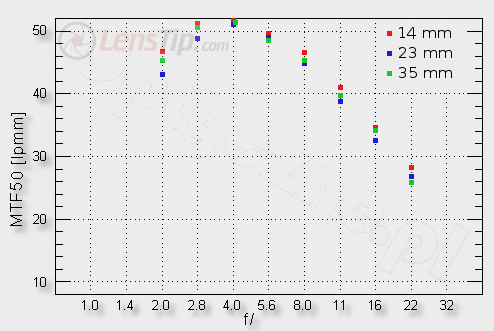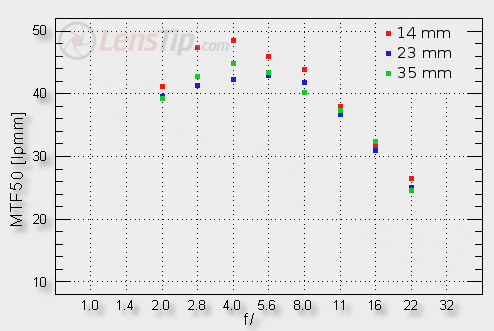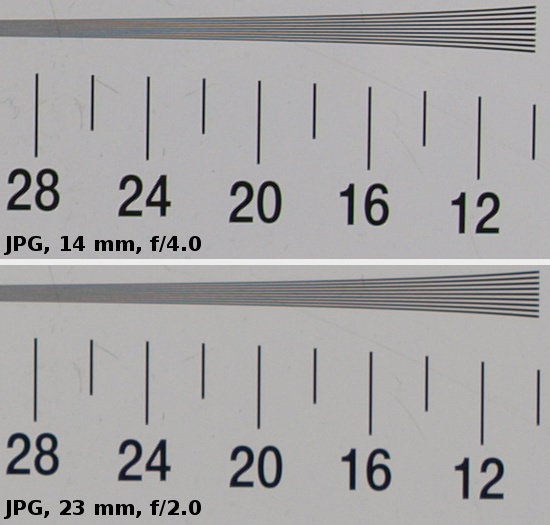Olympus Zuiko Digital ED 14-35 mm f/2.0 SWD
4. Image resolution
Let’s look how the Zuiko Digital ED 14-35 mm f/2.0 SWD performs in the frame centre.

Please Support UsIf you enjoy our reviews and articles, and you want us to continue our work please, support our website by donating through PayPal. The funds are going to be used for paying our editorial team, renting servers, and equipping our testing studio; only that way we will be able to continue providing you interesting content for free. |
- - - - - - - - - - - - - - - - - - - - - - - - - - - - - - - - - - - - - - - - - - - - - - - -
Well, well. Only one word comes to mind here – impressive. The performance of the lens is perfectly even – the differences between particular focal lengths are very small. What’s more, by f/4.0 at all focal lengths we reach results near 51 lpmm. Practically no system fixed focal length lens can fare better. At the maximum relative aperture the Olympus lens performs very well too. The MTFs we get there are in the range from 43 to 47 lpmm so the images are sharp indeed. Only the best lens of 24–70ámm f/2.8 class which have been tested by us, namely the Sony Carl Zeiss Vario Sonnar 24–70ámm f/2.8 T* SSM, can compete with the Olympus here. It also showed a very even performance and at the maximum aperture gave us images with equally great sharpness. The Nikkor AF-S 24–70ámm f/2.8G ED and theáSigma 24–70ámm f/2.8 EX DG HSM fare a bit worse here and the Canon EF 24–70ámm f/2.8L USM lags behind the most, as at the maximum aperture it barely brushed against the decency level. The Canon is the oldest lens in this group, though, and supposedly the first to be replaced by a newer model.
What does the edge of the frame look like? Let’s have a glance at the graph below.

The word „impressive” still describes perfectly the performance we see here. Even at the maximum relative aperture the MTFs reach nearly 40 lpmm, exceeding safely the decency level. On slight stopping down the MTFs increase to levels which would be very hard to criticize. The lost of that evenness of performance at all focal lengths is one thing that can be regretted here- it becomes especially visible in the frame centre. Now, we can notice that 14 mm focal length is significantly better than the 23-35 mm range. Such a problem is not serious at all, though. Especially that the Olympus compares so well with its full frame competitors. To make this comparison completely fair we should take into account the results of other full frame lenses at the edge of full frame. There, at the maximum aperture, few devices exceed the decency level. Some of them don’t manage it even on stopping down by 1 EV. The advantage of the Olympus is clear and indisputable then.
At the end we would like to present our test chart crops, saved in JPEG format along with the RAW files, which were used to determine the MTF50 values.
 |






